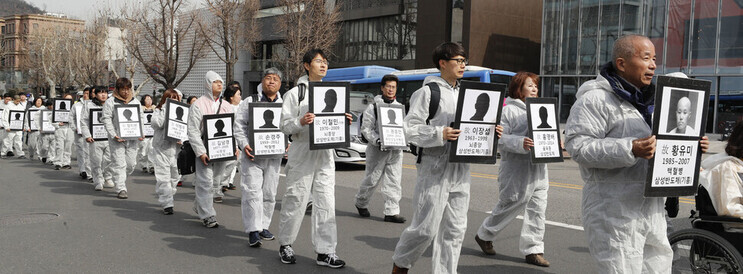hankyoreh
Links to other country sites 다른 나라 사이트 링크
Toxins linked to occupational diseases at Samsung found on more of its production lines

Carcinogenic substances and toxins that can wreak havoc on the reproductive system cited in connection with occupational diseases among workers who make Samsung’s semiconductors are also present in large proportions among the chemicals used to produce other Samsung items such as batteries and cell phones, a study has shown.
This has prompted calls for stronger management of hazardous chemicals not only in the semiconductor workplaces where the occupational disease issue has mainly been focused but also in other Samsung-affiliated electronics production workplaces.
According to an examination Sunday of a report on worker safety and health conditions at Samsung affiliates that produce electronics, the proportion of carcinogenic and reprotoxic substances among the hazardous chemicals used to produce items in areas such as wireless communications, home appliances, and batteries was similar to or higher than in semiconductor workplaces.
The report in question was drafted by the semiconductor workers’ health and human rights watchdog group SHARPS — short for Supporters for the Health and Rights of People in the Semiconductor Industry — and the Korea Institute of Labor Safety and Health, among others.
The study involved using material safety data sheet information from the Korea Occupational Safety and Health Agency to classify the nature of substances on a list of hazardous chemicals provided by Samsung Electronics and Samsung SDI, which has been made public on the National Chemicals Information System.
In particular, researchers focused on the percentages of substances that have the potential to cause cancer or harm the human reproductive process, which have been cited in cases of occupational diseases associated with Samsung semiconductor production, including rare forms of cancer and second-generation occupational diseases suffered by fetuses.
According to the results, 16% of the 77 hazardous chemicals used for the production of cell phones and other wireless communication items were found to be carcinogens. Twenty-one percent were carcinogenic, mutagenic and reprotoxic, or CMR, substances, which can lead to second-generation occupational diseases.
For Samsung SDI’s battery sector, a total of 43 chemicals were used, with 23% of them classified as carcinogenic and 37% as CMR.
These levels were similar to or higher than the ones in Samsung Electronics’ semiconductor sector, where safety facilities were expanded by the company after the controversy surrounding the death of Hwang Yu-mi, who worked at a Samsung semiconductor plant. Of the 146 chemicals used by Samsung Electronics in the manufacturing of semiconductor chips, 12% were carcinogenic and 17% were classified as CMR.
The results of surveys and interviews with Samsung Electronics and Samsung SDI workers suggested that safety management in the production of home appliance batteries is laxer than for semiconductors.
Commenting on the equipment in place to prevent exposure to hazardous substances, one Samsung SDI worker who was interviewed said, “There is shielding and exhaust equipment, but it’s poor. There are [still] smells and particles.”
In a survey, 308 Samsung Electronics workers were asked whether they or their colleagues had suffered from cancer or rare diseases. Fifteen percent of workers at a home appliance workplace in Gwangju and 12.2% of those at a home appliance and communications workplace in Gumi answered affirmatively — roughly double the rates for the semiconductor workplaces in Giheung, Hwaseong, Pyeongtaek and Onyang.
These findings have prompted calls for stronger chemical safety management at workplaces in areas that have received less social attention than semiconductors — including batteries, cell phones and home appliances — in light of the potentially huge impact on worker health.
“Now that we know more about the hazardous working environments in the electronics industry beyond semiconductors, I hope it leads to the acknowledgment of occupational diseases and improvements to these working environments,” said Lee Sang-su, a SHARPS organizer who took part in writing the report.
In response, Samsung Electronics said that it “complies with the relevant Korean and overseas regulations and laws in terms of management of chemical substances.”
By Jang Hyeon-eun, staff reporter
Please direct questions or comments to [english@hani.co.kr]

Editorial・opinion
![[Column] Life on our Trisolaris [Column] Life on our Trisolaris](https://flexible.img.hani.co.kr/flexible/normal/500/300/imgdb/original/2024/0505/4817148682278544.jpg) [Column] Life on our Trisolaris
[Column] Life on our Trisolaris![[Editorial] Penalties for airing allegations against Korea’s first lady endanger free press [Editorial] Penalties for airing allegations against Korea’s first lady endanger free press](https://flexible.img.hani.co.kr/flexible/normal/500/300/imgdb/original/2024/0502/1817146398095106.jpg) [Editorial] Penalties for airing allegations against Korea’s first lady endanger free press
[Editorial] Penalties for airing allegations against Korea’s first lady endanger free press- [Editorial] Yoon must halt procurement of SM-3 interceptor missiles
- [Guest essay] Maybe Korea’s rapid population decline is an opportunity, not a crisis
- [Column] Can Yoon steer diplomacy with Russia, China back on track?
- [Column] Season 2 of special prosecutor probe may be coming to Korea soon
- [Column] Park Geun-hye déjà vu in Yoon Suk-yeol
- [Editorial] New weight of N. Korea’s nuclear threats makes dialogue all the more urgent
- [Guest essay] The real reason Korea’s new right wants to dub Rhee a founding father
- [Column] ‘Choson’: Is it time we start referring to N. Korea in its own terms?
Most viewed articles
- 160% of young Koreans see no need to have kids after marriage
- 2[Reporter’s notebook] In Min’s world, she’s the artist — and NewJeans is her art
- 3Hybe-Ador dispute shines light on pervasive issues behind K-pop’s tidy facade
- 4[Column] Life on our Trisolaris
- 5[Editorial] Penalties for airing allegations against Korea’s first lady endanger free press
- 6Presidential office warns of veto in response to opposition passing special counsel probe act
- 7S. Korea discusses participation in defense development with AUKUS alliance
- 8Vietnamese war victims speak of sexual violence by S. Korean troops for the first time
- 9Months and months of overdue wages are pushing migrant workers in Korea into debt
- 10Inside the law for a special counsel probe over a Korean Marine’s death